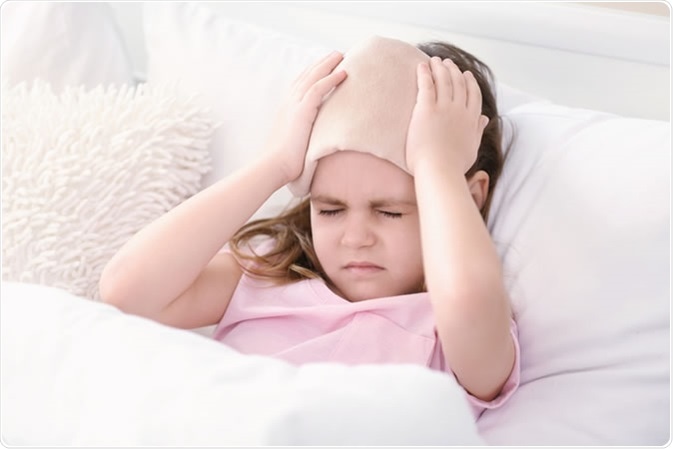
Pediatric Migraine – Diagnosis and Treatment
Skip to:
- Diagnosis of pediatric migraine
- Laboratory tests and neuroimaging
- Management of pediatric migraine
- Acute treatment, chronic management, and pharmacotherapy
- Lifestyle modifications
Pediatric migraine is the most common type of primary headache seen in children. They are headaches that are characterized by a throbbing sensation in the head, which may be accompanied by signs and symptoms such as nausea, vomiting, and photophobia.
As many as 6 in 10 children may complain of headaches during their childhood years, and of these, only approximately 10 percent suffer from migraines.
The prevalence of pediatric migraine increases with increasing age. Moreover, it tends to be more frequently seen in females than males during the years of puberty. However, the gender distribution is relatively equal before this period.
What makes migraines in the pediatric population particularly challenging to identify and manage is the fact that children often have difficulties in expressing the nature of their ailments.
As a result, many cases may go undiagnosed and untreated.

Image Credit: Africa Studio / Shutterstock
Diagnosis of pediatric migraine
Diagnosing pediatric migraines requires a detailed clinical history with a full neurological examination.
The extremes of young age complicate diagnosis, and in children who do not present with the typical signs and symptoms of migraine. According to the ICHD-3, there needs to be a minimum of five migraine attacks before making a diagnosis of pediatric migraine.
In children, migraine attacks may span anywhere from 2 hours to 3 days. In contrast to adults, migraines in children are generally bilateral.
Unilateral presentation is seen towards the end of childhood. Furthermore, accompanying symptoms, such as photophobia and phonophobia are not always explicitly given, and may need to be inferred based on patterns of behavior.
Neurological imaging modalities are not always necessary, especially with pediatric anamnesis of typical presentation. However, imaging is vital if there are abnormal findings on the neurological assessment of the child.
These abnormal findings include worsening headaches with changes in posture, double vision, and problems with balance, coordination, and speech. In these cases, secondary causes of the headache and neurological abnormalities should be suspected.
Laboratory tests and neuroimaging
If pediatric migraine is the primary cause of the headaches, there is no role for laboratory testing. Laboratory tests come in handy when secondary causes are suspected, as with metabolic disturbances and infections.
Likewise, neuroimaging done in children with typical migraine is usually unremarkable, and owing to the inherent dangers with radiation exposure associated with CT scans, this modality is not typically recommended in children with an anamnesis consistent with migraine. MRI may be considered, but again, it is not necessary in classically presenting cases.
Management of pediatric migraine
The management of pediatric migraines is primarily focussed on acute/ chronic therapy and preventive treatment in known cases.
The latter consists of lifestyle modifications. Parents and guardians must take steps to ensure that all is done to prevent migraines in the first instance in susceptible children.
Acute treatment, chronic management, and pharmacotherapy
In acute attacks, it is essential to stop physical activity, as this will only worsen the attack. Attempts at getting the child to sleep should be made, as sleep is perhaps the most potent antimigraine agent.
The room should be dark, as quiet as possible, and the child should be kept comfortable. Simple analgesics to ease the pain may be given, and antiemetics may be given for vomiting, if applicable.
In chronic cases, which are defined as 15 or more days with headache per month over three months, management should be tailored to focus on prevention.
Furthermore, precaution is advised against the overuse of pharmacotherapy used in acute settings for the management of chronic migraine, as this can cause more headaches. In chronic cases, cognitive behavioral therapy (CBT) should be considered, along with antimigraine prophylactic medications.
Lifestyle modifications
Simple adjustments to lifestyle to avoid migraine triggers are crucial in the management of pediatric migraines. It is of utmost importance to ensure that the child has healthy sleeping patterns and rest.
Furthermore, a healthy diet, thorough hydration, and regular exercise are just as important as sleep hygiene. Likewise, migraine education for the patient and family is necessary, as this is a tool of empowerment.
It will aid in early recognition of the premonitory signs and symptoms of migraine, which results in a rapid response to acute management. Furthermore, disease education allows for proper documentation of precipitating factors, and consequently, avoidance of triggers.
Sources
- Elser JM, Woody RC. Migraine headache in the infant and young child. Headache. 1990;30(6):366–368. doi:10.1111/j.1526-4610.1990.hed3006366.x https://www.ncbi.nlm.nih.gov/pubmed?term=2370139
- El-Chammas K, Keyes J, Thompson N, Vijayakumar J, Becher D, Jackson JL. Pharmacologic Treatment of Pediatric Headaches: A Meta-analysis. JAMA Pediatr. 2013;167(3):250–258. doi:10.1001/jamapediatrics.2013.508 https://www.ncbi.nlm.nih.gov/pmc/articles/PMC4692044/
- Lee LH, Olness KN. Clinical and demographic characteristics of migraine in urban children. Headache. 1997;37(5):269–276. doi:10.1046/j.1526-4610.1997.3705269.x pubmed.ncbi.nlm.nih.gov/.../?from_single_result=9195764
- The International Classification of Headache Disorders, 3rd edition (beta version) https://journals.sagepub.com/doi/epub/10.1177/0333102413485658
Further Reading
Last Updated: Feb 23, 2020























.png)









No hay comentarios:
Publicar un comentario